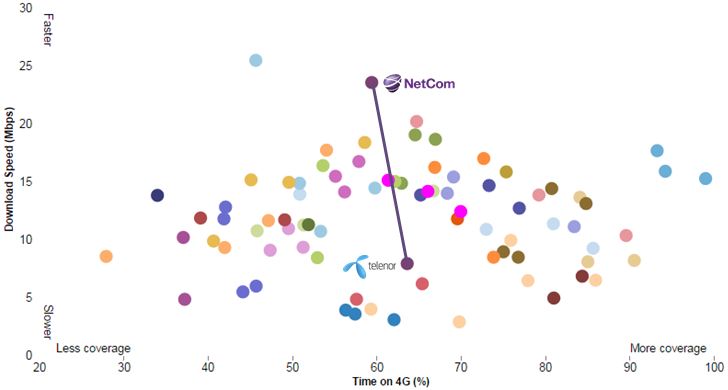After 14 years, BT is back into consumer mobile. The long-rumoured launch of BT Mobile happened today. Continue reading BT Mobile: Surprisingly disruptive
Category Archives: Consulting
Freedom to stay – The power of 40000 Tweets
Consumers often think of carriers being somewhat stuffy and dusty, being slow to give customers flexibility and big at small print. But there are great exceptions to the rule with T-Mobile in the US, Free in France and Tele2 in Sweden, and we believe the next two years will see some further fun, entertaining and disruptive carrier offerings on the market. Continue reading Freedom to stay – The power of 40000 Tweets
If you sell Mbytes, why slow your customers down?
We’ve been awaiting Telenor’s official comments to OpenSignal’s new crowdsourced 4G coverage and speed test, but since Telenor hasn’t yet commented it we try to interpret the Norwegian results ourselves.
Continue reading If you sell Mbytes, why slow your customers down?
Tele2: From industry’s black sheep to customer’s best friend?
 Late November last year, Tele2 launched a major transformation campaign in Sweden under the Tele2.0 banner.
Late November last year, Tele2 launched a major transformation campaign in Sweden under the Tele2.0 banner.
The message? Tele2 had questioned all industry practices and concluded that many of them were outright stupid. And consequently stopped or changed them. Continue reading Tele2: From industry’s black sheep to customer’s best friend?
Contributing to Comptel’s book “Operation Nexterday”
Analysis & Go-to-market 2015
 In cooperation with key Comptel experts, writing and editing key parts of Comptel’s book “Operation Nexterday” which was launched at Mobile World Congress 2015.
In cooperation with key Comptel experts, writing and editing key parts of Comptel’s book “Operation Nexterday” which was launched at Mobile World Congress 2015.
Four years (and a net neutrality law) later, Dutch operators foul again
Dutch operators KPN and Vodafone were both fined for violations of net neutrality today.
KPN got a fine of 250000 EUR for having blocked access to voice over IP services on public Wi-Fi hotspots. Vodafone was fined 200000 EUR for having zero-rated content from HBO. Continue reading Four years (and a net neutrality law) later, Dutch operators foul again
Rollover: The next big thing for customer retention
 Bucket plans – with volume caps on the number of minutes, messages and Mbytes – have been offered by mobile operators for years. Even though the composition has varied over time (e.g. through elements made unlimited), the concept is well known to customers.
Bucket plans – with volume caps on the number of minutes, messages and Mbytes – have been offered by mobile operators for years. Even though the composition has varied over time (e.g. through elements made unlimited), the concept is well known to customers.
Monthly caps have become the standard of our industry. Another standard is to reset those caps at the start of a new month. This means that any balance left – minutes, messages, Mbytes – is voided. Or confiscated – to use the word of John Legere, CEO of T-Mobile USA. Continue reading Rollover: The next big thing for customer retention
Speaker at the Wi-Fi Innovation Summit
Analysis & Consulting, 2014
 Preparing and presenting “How are telcos, cellcos and cablecos using Wi-Fi to strengthen existing business?” for 200 participants at the Wi-Fi Innovation Summit in Copenhagen 9-10 December.
Preparing and presenting “How are telcos, cellcos and cablecos using Wi-Fi to strengthen existing business?” for 200 participants at the Wi-Fi Innovation Summit in Copenhagen 9-10 December.
Some of the presented content is available in this analysis.
Identifying non-traditional initiatives to increase efficiency
Analysis & Consulting, 2014
Independently identifying and presenting customer-specific initiatives to increase efficiency to a key customer operator of a global services provider.
Quad and convergent play: tefficient provides fact-based recommendations
 Analysis & Go-to-market, 2014
Analysis & Go-to-market, 2014
How have operators introduced mobile-fixed convergent quad-play in Europe’s most advanced markets France, Spain, Portugal – and in emerging quad markets like Belgium, the Netherlands, the UK and Germany? How has competition reacted?
Using facts: How have these quad introductions affected market share, churn, acquisition & retention cost, demand for mobile, fibre-speed broadband and TV – and revenue and margin? Which defensive actions can non-convergent operators take?
Which factors can be attributed to effective take-up of quad play? Market share, fibre deployment and homepass, TV offers, exclusive content – or is it just about bundling discounts? What discount levels are we talking about?
Based on international facts and best practice, what would tefficient recommend? Taking local conditions, operator strategy and market position into account.
Commissioned by two operators.



